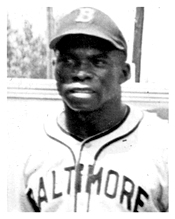

Henry Allen Kimbro
Nicknames: Kimmie, Jimbo, Scooter Motoneta
Career: 1937-1950
Positions: cf, lf, manager
Teams: Washington Elite Giants (1937), Baltimore Elite Giants (1938-1940, 1942-1951), New York Black Yankees (1941), Birmingham Black
Barons (1952-1953)
Bats: Left
Throws: Right
Height: 5' 8'' Weight: 175
Born: February 19, 1912, Nashville, Tennessee
A compact blend of speed and power, Kimbro starred in the Negro Leagues for fourteen years, all except one season with the Baltimore Elite Giants. In 1941 he was traded to the New York Black Yankees for Charley Biot, but returned with the Elites the following year. An all-around ballplayer, Kimbro excelled in the field, at bat, and on the bases. A good defensive center fielder with great range and a good arm, he was regarded as the best center fielder in the Negro National League in his prime. He was especially adept at going into the alleys on flys but was a little weak on fielding ground balls in the outfield. Equally dangerous offensively, he was an outstanding line-drive hitter for both average and power and was a constant base-stealing threat. His sharp eye and superior speed made him an ideal lead-off batter and, hitting from the left side but to left field, he utilized his speed to get leg hits on ground balls to the infield, and to augment his normal power by stretching would-be singles into extra-base hits.
One of the teams' sluggers, Kimbro had strong arms and shoulders and was consistently among the league leaders in a variety of major offensive categories. In 1944 he hit .329, led the league in stolen bases, and finished only one home run behind league leaders Josh Gibson and Buck Leonard; in 1945 he hit .291 and tied with "Cool Papa" Bell for the league lead in at-bats; in 1946 he hit .371 and led the league in runs scored; in 1947 he hit .353, led the league in runs scored, and tied for the lead in doubles. In three of these seasons he finished in the top ten hitters in batting average as well, and he appeared in six All Star games.
Before and after these peak seasons he was also a very productive hitter. In his first year in the Negro National League he hit .276, one of the few times that he failed to hit .300 during his career. The next year two seasons he was credited with averages of .318 and .310, but after dropping to .269 in 1940, he was traded to the Black Yankees, where he hit .247 in his only season before returning to the Elites for seasons of .288 and .333 in 1942-1943. In 1948, the last year before the Negro National League folded, he hit .314, and after the Elites joined the Eastern Division of the Negro American League, he hit .352 and .370 in 1949-1950, with the latter effort being fourth best in the league. Although the quality of play in the Negro American League dropped to a minor league level during the early 1950s, Kimbro continued to play for three more years, moving to the Birmingham Black Barons in 1952-1953.
He was also a star in the Caribbean winter leagues, leading the Cuban League with a .346 batting average with Havana in 1947-1948, and leading the league with 18 stolen bases while hitting .294 with Almendares in 1939-1940. When the color bar was removed, the Nashville native was thirty-three years of age and, by major-league standards, too old to make the transition. A loner described as intense, aloof, and "evil," he played with a fierce determination. Baseball to him was just another job, but he was a smart player and served a brief stint as manager at one point in his career. After retiring from baseball he channeled his efforts into building a business and now operates a successful service station and cab dispatch.
Source: James A. Riley, The Biographical Encyclopedia of the Negro Baseball Leagues, New York: Carroll & Graf Publishers, Inc., 1994.

Henry Kimbro